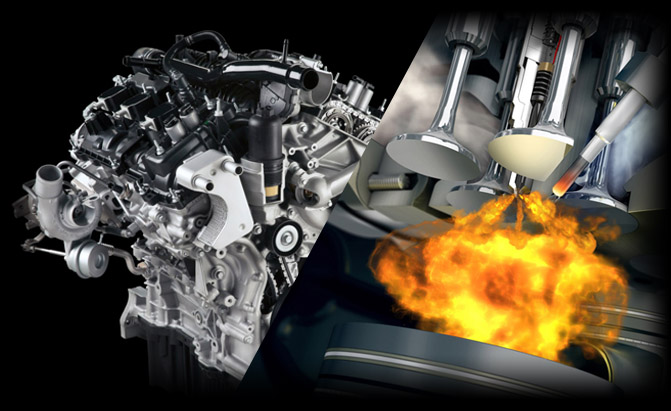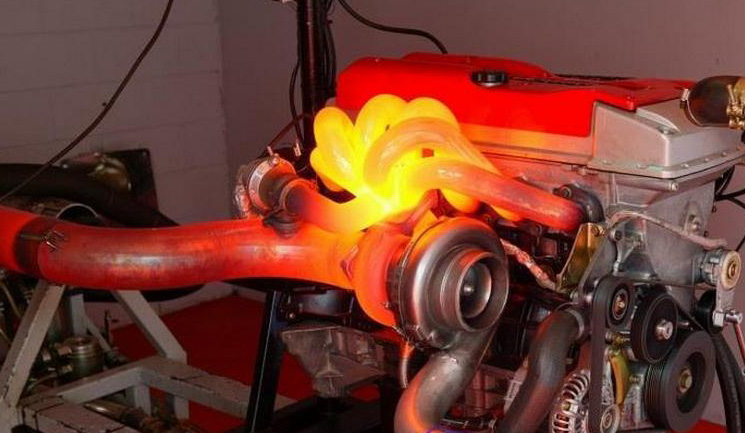The physics of turbochargers (for dummies)
So many cars are turbocharged these days. In the immortal words of Pauline: Please explain. (This report is rated ‘P’ and ‘B’ and ‘G’ - for physics in the beer garden.)
This report is inspired by a question from JB007:
"Thirty years ago I was told the heat loss through the turbo causes it to turn and I have been trying to get my head around this ever since. In other words, heat loss creates a pressure differential that creates flow. It’s still bending my brain. How does this work?" - JB007
I did a recent report on small turbos >>. They’re increasingly common, in which I said that turbos are driven fundamentally by flow, and not heat. This is 100 per cent true.
However - big however - I could make the somewhat more obtuse claim that everything in your car is driven by heat. Even the radio. Even the alternator. It’s called an internal ‘combustion’ engine. Combustion drives everything.
COMBUSTION
Combustion is the process that drives everything. Fuel has a high amount of stored energy. Combustion byproducts (CO2 and water) have a low amount of stored energy.
The difference in the two stored energy states is liberated and used for motivation (and subsequently to drive the alternator/radio, etc.)
But it’s both obtuse and unfair to say that heat drives the pistons or the turbo. At least, it doesn't directly. So let’s look at that.
Heat from combustion affects the gasses in the combustion chamber. It ramps up the pressure, and it’s the pressure over the area of the piston that forces the piston down in the bore, from which mechanical work is derived via the con-rod and the crankshaft.
It’s the heat that energises the gas in the combustion chamber. And it’s the energetic state of the gas that does the mechanical work on the piston. That makes sense, right?
And trust me - we’re getting to the turbo.
BUT FIRST, A GREAT LOSS...
It would of course be awesome if all the energy in the combusted gasses were converted into motion of the car. But it’s not.
You need to use some of it to overcome internal friction in the engine. And you need to drive the alternator, the water pump, and the oil pump. Without them, it doesn’t end well.
And you need to use some of that energy to compress the inlet fuel-air mixture getting ready to go ‘bang’ in a nearby cylinder. So there’s that. And this is basically why there’s not 100 per cent energy conversion in the engine - even though combustion itself is basically complete in a modern engine.
And - and this is a big ‘and’ - you just throw some of that apparently serviceable energy away, out the exhaust pipe. It’s this wasted energy - at least some of it - that is used to drive the turbocharger.
HOW EXHAUST REALLY WORKS
Suck, squeeze, bang and blow: four of my favourite things. Especially bang and blow. Fuel-air mix goes ‘bang’ - the charge in the chamber is rapidly energised.
That exhaust gas basically stores energy in three ways: pressure, heat and motion.
It gets rapidly hot, the pressure ramps up and the piston gets flung down. Towards the bottom of the stroke, before the bottom, the exhaust valve opens. The gas is still highly energised at this time, so it rushes out the exhaust valve.
People often think that it’s the upwards motion of the piston that pumps out the exhaust gas, but this is overwhelmingly bullshit. Exhaust gas throws itself out the door. If the upwards motion of the piston pumped it out, the engine would incur significant pumping losses and it wouldn’t be as efficient.
Engines aren't pumps.
So there’s a lot of energy still in the exhaust gas as it exits the cylinder and enters the exhaust manifold. You can see it in the photograph (below, right) which is kind of an extreme case of an engine operating at peak power for an extended period. The headers are yellow. You could ballpark the hotspot at 1000 degrees C. (I wouldn’t be standing too close.
Latest internal combustion tech coming soon: HCCI ignition >>
TURBOS & ENERGY
The energy inside the gas in those headers exists in the form of heat, pressure and motion. Because it’s pressurised relative to atmosphere it’s on the hunt for a way out, and the only exit sign is hanging over the entry to the exhaust turbine part of the turbocharger. It’s like a pressure release valve.
Lots of processes take place here. The pressure inside the exhaust manifold is caused by heat - because there’s a direct, linear relationship between absolute temperature and pressure. So there’s high pressure on the engine side and relatively low pressure on the exit side.
Therefore, there’s flow. (Because gasses flow from areas of high to low pressure.)
Gasses have mass. Exhaust is mainly nitrogen gas, CO2 and steam. They’ve all got mass. If you’ve got mass and flow, you’ve got kinetic energy. So the heat and pressure turns into kinetic energy by virtue of its motion through the turbine.
The gas also has viscosity - which is a fancy way of saying it just doesn’t like being pushed around. Or at least it resists being pushed around. So it hits the turbine blades on its way out out the door and the resistance translates to force acting on the blades, and that spins the turbine, which is connected to the compressor on the other end of the shaft.
The compressor pressurises the air on the way into the engine, and that’s basically the mechanism for transferring energy that would have been wasted in the exhaust to additional energy in the inlet air stream (in the form of pressure).
THE HEAT IS ON
A couple of points on this: Several people took issue with the fact that I said turbochargers are not driven by heat. And I stand by that statement - a turbocharger is driven by mechanical flow - kinetic energy and viscosity. The gas that flows is energised by heat, certainly, but you cannot drive a turbine by heat - you need flow.
If you want to claim it’s heat also driving your alternator, then yeah - OK. We’re totally on the same page here.
There’s an inconvenient but simple thing called the first law of thermodynamics, which basically covers the conservation of energy. It essentially says the sum of work and energy in a closed system is constant in the time domain.
So if you put a box around the turbine in a turbocharger, you’ve got energy going in (in the form of highly pressurised, hot gas). You can see it’s hot because it’s heating up the headers to bright yellow while it waits for its turn to go through.
You’ve got energy coming out, in the form of mechanical work done spinning the turbocharger (the rotational kinetic energy acquired by the turbine and the compressor). And also in the form of the energy left in the exhaust gas after it passes through the turbine.
NOT BREAKING THE 1st LAW
Energy in has to equal energy out, or you violate the first law, and that’s not allowed. So the energy coming out of the turbine equals the energy on the way in minus the work done on the turbine and compressor.
The total energy of the exhaust gasses after the turbo must be less than before the turbo.
And you can see in the hot turbo photo above that this is indeed the case because it’s almost white-hot on the way in, and it’s only kinda red hot on the way out.
It’s definitively at a lower temperature on the output side of the turbine (you can see that) and the pressure is also lower (otherwise there wouldn’t be flow in that direction).
These are two of the definitively key indicators of the energy state of any gas, all other things being equal.
DUMBING IT RIGHT DOWN
So instead of thinking about this like: ‘How does the temperature difference (or heat loss) drive the turbocharger?’ just think about it like this (at the risk of dumbing it down to the point where even a politician would get it):
You’ve got high energy gas going into the turbo. It comes out at a lower energy, and the difference between the energy states, before and after, is the energy that’s been returned to the engine by the turbocharger.
The temperature and the pressure differences are just individual pieces in the thermodynamics jigsaw puzzle.
Just for the moment of Zen here, I really want you to appreciate more than just the incredible thermodynamic magic trick being done, transferring otherwise waste energy back into the engine in such an elegant way.
BRILLIANT ENGINEERING
Making a turbocharger work is an incredible feat. Because it’s a high-speed, high-precision part operating in a tremendously inhospitable environment. By rights, they should all blow up, every minute of every day.
Even a mundane turbocharger on a small engine today can spin at probably 150,000 rpm.
That’s 2500 revolutions per second. Per second. OMFG. (A smaller one might spin twice as fast.)
It’s a complete brain bender.
The turbine is spinning at this incredible speed while it’s at 1000 degrees C - without melting or falling apart. That’s pretty clever. It spins in bearings lubricated by pressure-fed oil, which cannot be allowed to overheat. There’s one bearing that’s just centimetres away from the bits at 1000 degrees.
Sometimes there’s a water jacket just centimetres away - it’s doing the heavy-duty temperature regulation of the bearing environment. The water’s not allowed to boil. Ever. So there’s a temperature gradient of 850-odd degrees operating inside the turbo.
CONCLUSION
Turbochargers are insane. Brilliantly insane. Insanely brilliant. (Both those things.) They're impossibly cool, for something so friggin hot.
So to all you ladies out there I would suggest you need to understand how breathtakingly sexy hardcore engineering like this really is, and then take appropriate steps in the selection of a partner for the purposes of breeding (or even just practicing)...
You must henceforth stop idolising men who can kick a ball, catch a ball, hit a ball or throw a ball, and start concentrating instead on on the ones who have mastered the only organ that really matters.
If you learn only one thing from this report, let it be that.
Gagging for more? Here's the 'not for dummies' version >> plus a good report on future turbo tech challenges >>









